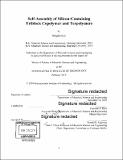Self-assembly of silicon-containing triblock copolymer and terpolymers
Author(s)
Lee, Sangho(Scientist in materials science and engineering)Massachusetts Institute of Technology.
Download1102048282-MIT.pdf (8.996Mb)
Other Contributors
Massachusetts Institute of Technology. Department of Materials Science and Engineering.
Advisor
Caroline A. Ross.
Terms of use
Metadata
Show full item recordAbstract
The block copolymer (BCP) self-assembly has garnered significant interest due to its ability to generate periodic nanostructures with a variety of morphologies. Compared to diblock copolymers that have been extensively studied to form the conventional morphologies such as spheres, cylinders, and lamellae depending on the block volume fraction, more complex polymer architectures are expected to offer additional degrees of freedom and a wider range of structures. Solvent vapor annealing (SVA) using a continuous gas flow system allows a precise control over the annealing condition, which can capture intermediate morphologies including perforated lamellae and gyroids and can create unique nanostructures that have not been observed in diblock copolymers. Combining with self-consistent field theory (SCFT) modeling and in situ grazing-incidence small-angle X-ray scattering (GISAXS) measurement, the phase behavior of advanced polymer architectures can be revealed in details. Here, the self-assembly behavior of silicon-containing triblock copolymer and terpolymers in multi-layered films under SVA is presented. Using both experimental and SCFT approaches, the phase behavior of poly(stryrene-b-dimethylsiloxane-b-styrene) (PS-b-PDMS-b-PS or SDS32) thin films was investigated as a function of the as-cast film thickness and the ratio of two different solvent vapors, toluene and heptane. In comparison with diblock PS-b-PDMS with same molecular weight, the SDS32 offers a simple route to produce a diversity of well-ordered bilayer structures with smaller feature sizes, including the formation of bilayer perforated lamellae over a large process window. In addition, the morphological evolution of core-shell cylinder-forming triblock terpolymers during SVA was monitored in situ using GISAXS. A reversible order-order phase transformation between spheres and cylinders occurred during the annealing process. One of the final morphologies consisted of the regions of in-plane cylinders, with the majority of the film comprising vertical core-shell cylinders passing through perforated lamellae of poly 1,1-dimethyl silacyclobutane (PDMSB).
Description
Thesis: S.M., Massachusetts Institute of Technology, Department of Materials Science and Engineering, 2019 Cataloged from PDF version of thesis. Includes bibliographical references.
Date issued
2019Department
Massachusetts Institute of Technology. Department of Materials Science and EngineeringPublisher
Massachusetts Institute of Technology
Keywords
Materials Science and Engineering.